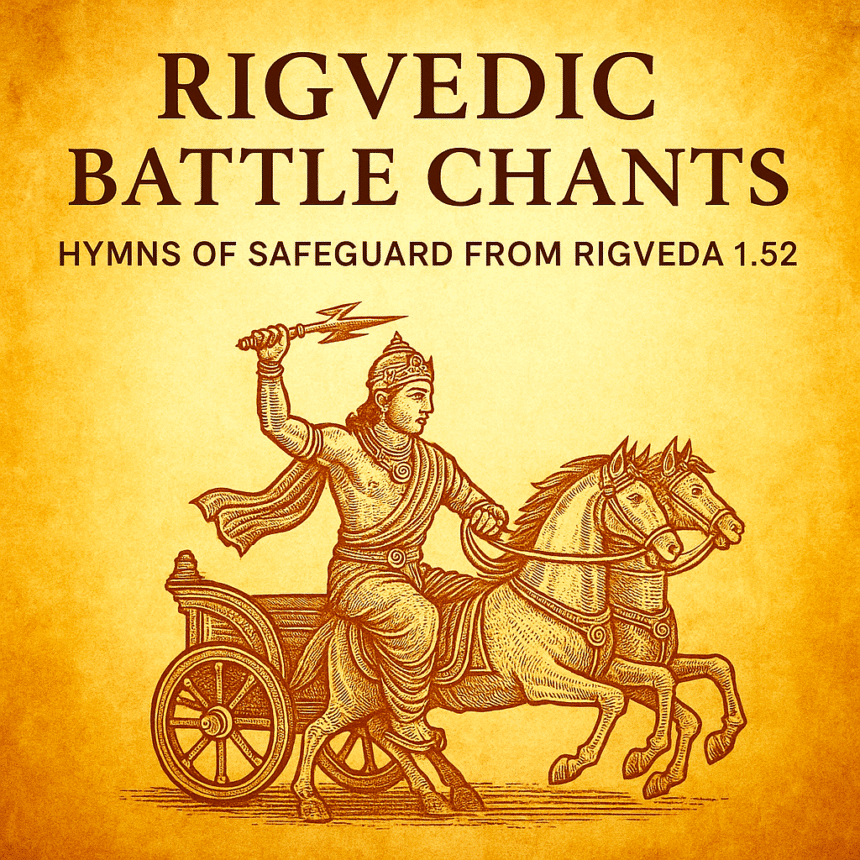Rigvedic Battle Chants: Hymns of Safeguard from Rigveda 1.52
Part XII – Hymns of Safeguard
Rigvedic Battle Chants from Rigveda 1.52
In the spiritual battlefield of our times, where ideological invasions and cultural erasures challenge the very survival of dharmic identity, the Rigvedic Battle Chants offer not only inspiration—but protection. These chants, encoded in the ancient hymns of the Rigveda, particularly Sukta 1.52, form part of a divine sonic arsenal, empowering individuals and communities to invoke cosmic strength and spiritual armor.
This blog continues our sacred series of Hymns of Safeguard, focusing on the thunderous might of Indra—the celestial warrior—who leads the charge against ignorance, suppression, and adharma. Each verse is not a passive prayer but an active declaration of divine power.
The Essence of Rigvedic Battle Chants
The term Rigvedic Battle Chants refers to potent mantras extracted from the Rigveda that embody divine intervention in the face of overwhelming obstacles. They are not metaphorical, but literal descriptions of cosmic battles—encoded as hymns to awaken inner strength and cosmic protection.
Sukta 1.52 is among the most powerful collections of such chants, where Indra, the wielder of the Vajra (thunderbolt), is portrayed as a liberator, destroyer of enemies, and restorer of universal order.
Rigveda 1.52.2: Indra Breaks the Bonds
Sanskrit:
स पर्व॑तो॒ न ध॒रुणे॒ष्वच्यु॑तः स॒हस्र॑मूति॒स्तवि॑षीषु वावृधे ।
इंद्रो॒ यद्वृ॒त्रमव॑धीन्नदी॒वृत॑मु॒ब्जन्नर्णां॑सि॒ जर्हृ॑षाणो॒ अंध॑सा ॥
Transliteration:
sa parvato na dharuṇeṣv acyutaḥ sahasram-ūtiḥ staviṣīṣu vāvṛdhe |
indro yad vṛtram avadhīn nadī-vṛtam ubjann arṇāṃsi jarhṛṣāṇo ’ndhasā ||
Audio
Translation:
“He is like a mountain, unshaken in its base; Indra increased a thousandfold in might. When he slew Vṛtra, the blocker of rivers, he released the streams, rejoicing with Soma.”
Invocation Insight:
This Rigvedic Battle Chant initiates the battle by breaking stagnation and restoring flow. Obstacles that dam life—inner or outer—yield to invoked protective force.
Rigveda 1.52.5–6: The Strike of the Vajra
Sanskrit (1.52.5):
अ॒भि स्ववृ॑ष्टिं॒ मदे॑ अस्य॒ युध्य॑तो र॒घ्वीरि॑व प्रव॒णे स॑स्रुरू॒तयः॑ ।
इंद्रो॒ यद्व॒ज्री धृ॒षमा॑णो॒ अंध॑सा भि॒नद्व॒लस्य॑ परि॒धीँरि॑व त्रि॒तः ॥
Sanskrit (1.52.6):
परीं॑ घृ॒णा च॑रति तित्वि॒षे शवो॒ऽपो वृ॒त्वी रज॑सो बु॒ध्नमाश॑यत् ।
वृ॒त्रस्य॒ यत्प्र॑व॒णे दु॒र्गृभि॑श्वनो निज॒घंथ॒ हन्वो॑रिंद्र तन्य॒तुं ॥
Transliteration (1.52.5):
abhi sva-vṛṣṭiṁ made asya yudhyato raghvīr iva pravaṇe sasrur ūtayaḥ |
indro yad vajrī dhṛṣamāṇo ’ndhasā bhinad valasya paridhīn iva tritaḥ ||
Transliteration (1.52.6):
parīṁ ghṛṇā carati titviṣe śava o ’po vṛtvī rajasō budhnam āśayat |
vṛtrasya yat pravaṇe durgṛbhiś vano ni jaghantha hanvor indra tanyutum ||
Audio
Translation:
“Our protections sped like swift steeds to the warrior in his ecstasy. When Indra, the Thunderer, charged with Soma, he broke Vala’s enclosures and smashed Vṛtra’s jaws with thunder.”
Invocation Insight:
These Rigvedic Battle Chants embody overwhelming victory. When resistance feels immovable, chant to convert intent into thunder—cutting through suppression, fear, and fatigue.
Rigveda 1.52.8: Light After the Storm
Sanskrit:
ज॒घ॒न्वाँ उ॒ हरि॑भिः संभृतक्रत॒विंद्र॑ वृ॒त्रं मनु॑षे गातु॒यन्न॒पः ।
अय॑च्छथा बा॒ह्वोर्वज्र॑माय॒समधा॑रयो दि॒व्या सूर्यं॑ दृ॒शे ॥
Transliteration:
jaghanvāṁ u haribhiḥ saṃbhṛta-kratav indra vṛtraṁ manuṣe gātu-yan napaḥ |
ayacchathā bāhvor vajram āyasam adhārayo divyā sūryaṁ dṛśe ||
Audio
Translation:
“Indra, with his golden steeds and gathered will, slew Vṛtra and set the waters free for mankind; with iron thunderbolt in both hands, he fixed the sun in heaven for all to see.”
Invocation Insight:
The chant turns from destruction to illumination. Protection culminates in restored order—waters flow, the sun returns, clarity prevails.
Rigveda 1.52.10–11: Shattering the Cosmos of Fear
Sanskrit (1.52.10):
द्यौश्चि॑द॒स्याम॑वाँ॒ अहेः॑ स्व॒नादयो॑यवीद्भि॒यसा॒ वज्र॑ इंद्र ते ।
वृ॒त्रस्य॒ यद्ब॑द्बधा॒नस्य॑ रोदसी॒ मदे॑ सु॒तस्य॒ शव॒साभि॑न॒च्छिरः॑ ॥
Sanskrit (1.52.11):
यदिन्न्विं॑द्र पृथि॒वी दश॑भुजि॒रहा॑नि॒ विश्वा॑ त॒तनं॑त कृ॒ष्टयः॑ ।
अत्राह॑ ते मघव॒न्विश्रु॑तं॒ सहो॒ द्यामनु॒ शव॑सा ब॒र्हणा॑ भुवत् ॥
Transliteration (1.52.10):
dyauś cid asyāmavāṃ aheḥ svanād ayoyavīd bhiyasā vajra indra te |
vṛtrasya yad badbadhānasya rodasī made sutasya śavasābhinac chiraḥ ||
Transliteration (1.52.11):
yad in nv indra pṛthivī daśabhujir ahāni viśvā tatananta kṛṣṭayaḥ |
atrāha te maghavan viśrutaṁ saho dyām anu śavasā barhaṇā bhuvat ||
Audio
Translation:
“The heavens themselves recoiled at the serpent’s roar; yet, O Indra, your lightning—fortified by Soma—split Vṛtra’s head. Even if the earth were tenfold in span, your power would still prevail, famed through heaven and earth.”
Invocation Insight:
At this crescendo, Rigvedic Battle Chants proclaim cosmic invincibility. Invoke them when the fight feels too vast—dharma’s aligned strength shatters the illusion of the unbeatable.
Practical Guide to Using Rigvedic Battle Chants
These are not ornamental verses. They are living forces. To use them effectively:
1) Sacred Setup
Designate a clean, quiet corner. Light a lamp or incense. Let the space prepare your mind.
2) Focused Recitation
Pronounce with care—Sanskrit is sonic science. Repetition counts: 11, 21, 108—choose your rhythm.
3) Intent as the Weapon
Set your purpose before beginning. Are you invoking protection, clarity, strength? Visualize the outcome.
4) Dharma-Rooted Use Only
These are weapons of light, not tools of vengeance. Invoke for the protection of self, family, and society—never for personal harm.
Alternative Meditative Method: Passive Immersion for Daily Life
Not everyone is ready to chant in Vedic Sanskrit or follow ritual precision. If the traditional Vedic method feels complex, there is still a path. Rigvedic Battle Chants are not confined to formal recitation—they can be absorbed through intentional listening with meaning in mind.
Understand the Essence First
Study a simple translation and context. Knowing what each hymn invokes—Indra’s thunderbolt, the shattering of obstacles, the release of strength—tunes the mind to receive power even in silence.
Practice Passive Immersion
- Sit comfortably; let the body be still.
- Play authentic Vedic audio of the chants.
- Close your eyes and listen—let sound wash through you.
- Consistency turns listening into transformation.
Incorporate Into Daily Routine
Replace background music while driving or doing chores with Rigvedic Battle Chants. Vedic vibration subtly purifies space and uplifts the mind—even without active focus. What matters is reverence; with aware listening, protection begins within.
Why Rigvedic Battle Chants Matter Today
These verses are not about ancient wars. They speak to today’s civilizational siege—where information is distorted, identity diluted, and dharma dismissed. Rigvedic Battle Chants become shields and swords—not of steel, but of sound, intent, and spiritual fire—protecting clarity, courage, and culture.
Call to Action: Rise in Practice, Not Just Praise
You’ve seen the threats. You know what’s at stake. It’s no longer enough to admire these verses from afar. Begin your daily invocation today.
Rigvedic Battle Chants are your inheritance. Use them as living tools—recite them, listen to them, share them—and let them awaken the warrior within.
To explore the broader context behind why these spiritual weapons matter, continue with our prior works:
Civilization Under Siege: Why Hindu Communities Face an Existential Crisis
Crisis Documented: Mathematical Evidence of Systematic Hindu Elimination
Credits
Audio Clips: By Sri Shyama Sundara Sharma and Sri Satya Krishna Bhatta. Recorded by © 2012 Sriranga Digital Software Technologies Pvt. Ltd. [Credit: https://sri-aurobindo.co.in/ Cut using https://mp3cut.net/]
Verse Texts: https://sri-aurobindo.co.in/
Feature Image: Click here to view the image.
Watch relevant Videos
Videos
Previous Blogs of the Series
- https://hinduinfopedia.org/civilization-under-siege-why-hindu-communities-face-an-existential-crisis/
- https://hinduinfopedia.org/crisis-documented-mathematical-evidence-of-systematic-hindu-elimination/
- https://hinduinfopedia.org/vedic-defense-mantras-rigvedas-protection-against-threats/
- https://hinduinfopedia.org/agni-suktas-for-protection-invoking-divine-fire-against-adharmic-forces/
- https://hinduinfopedia.org/indra-suktas-for-victory-invoking-the-divine-warrior-against-overwhelming-odds/
- https://hinduinfopedia.org/hymns-of-safeguard-an-ancient-armory-for-modern-crisis/
- https://hinduinfopedia.org/ashvini-kumar-suktas-for-divine-rescue-and-healing/
- https://hinduinfopedia.org/rigvedic-hymns-a-deeper-look-at-divine-protection/
- https://hinduinfopedia.org/vedic-defense-through-rigveda-richas-a-deeper-look-at-divine-protection/
- https://hinduinfopedia.org/mantras-for-defense-hardcore-rigvedic-protection-against-spiritual-disturbances/
- https://hinduinfopedia.org/vedic-invocations-of-power-indras-thunderbolt-and-the-eternal-hymns-of-safeguard/
Later Blogs



Leave a Reply